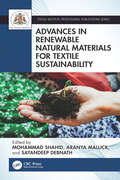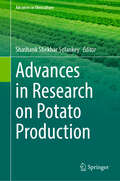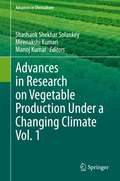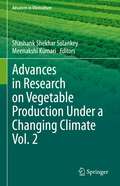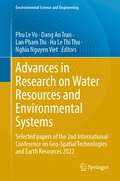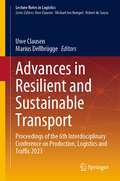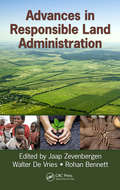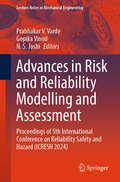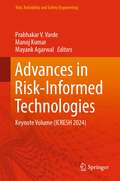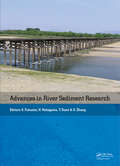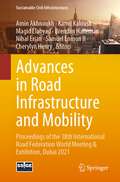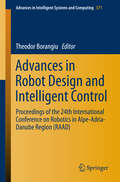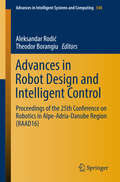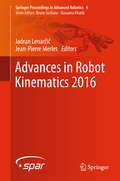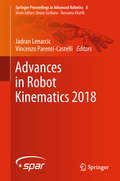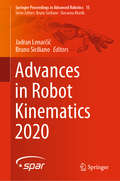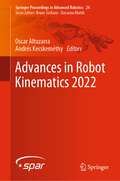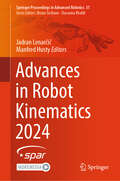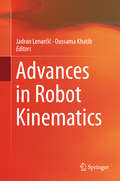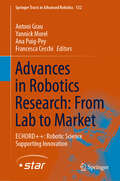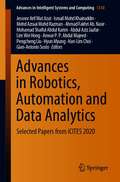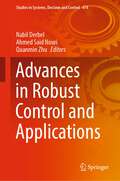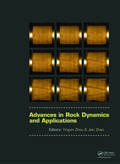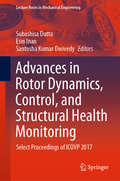- Table View
- List View
Advances in Renewable Natural Materials for Textile Sustainability (Textile Institute Professional Publications)
by Mohammad Shahid Aranya Mallick Sayandeep DebnathAdvances in Renewable Natural Materials for Textile Sustainability promotes sustainable practices in the textile industry through exploring the use of natural materials in textile production. The book delves into the advantages of using natural materials at every stage of textile processing, from fiber production to textile wet processing (dyeing, printing, finishing), and recycling after end use. The chapters provide critical discussions on natural materials for functional and smart textiles, sustainable methods of their preparation, application, and environmental impact of using biobased materials. It also discusses opportunities and challenges. Offers a comprehensive overview of the historical significance of natural fibers in textile production, the environmental impact of textile manufacturing, and the role of natural materials in reducing this impact. Provides examples of successfully implemented sustainable production processes. Discusses upcycling and repurposing of natural textile materials, sustainable textile waste management and recycling, and the use of natural colorants for dyeing and finishing textiles. Covers the use of biobased finishing agents, enzymes, and natural material-based auxiliaries in sustainable textile production and discusses biopolymers and nanocellulose and their potential in textile applications. Explores sustainable textile reinforcement using natural fibers and natural fiber-based composites and their applications. Considers the future of sustainable fashion and the role of natural materials in smart textiles for advanced applications like textile packaging, medical applications, textile sensors, and actuators, among others. With its comprehensive coverage, this book is an essential resource for professionals, researchers, and academics in the textile industry and anyone interested in sustainability in the fashion and textiles. It offers valuable insights for readers who want to make more informed choices and contribute to a more sustainable future.
Advances in Research on Potato Production (Advances in Olericulture)
by Shashank Shekhar SolankeyPotato (Solanum tuberosum L.) is the world&’s third-most important food crop and the fourth-most important food crop in India. Potatoes are nutritionally rich, fat free, gluten free and high in dietary fibre. They are also a good source of vitamin C, vitamin B6, phenols, iron, potassium, phosphorus, magnesium and protein as compared to cereals. They are more energy-packed than any other popular vegetables and have the ability to combat hidden hunger, which is a major global health issue. The potato is also considered the &‘king of vegetables&’ due to its versatile uses and is an important staple food worldwide According to the FAOSTAT database (2023), global potato production in 2022 was 375 million tonnes, with the top producers being China (95.5 million tonnes) and India (56 million tonnes). The United Nations declared 2008 the International Year of the Potato (IYP) to increase awareness of the relationship that exists between poverty, food security, malnutrition and the potential contribution of the potato in defeating hunger. Moreover, this magical crop can generate a higher yield compared to the other crops; hence, it is one of the most notable crops to eliminate hunger and poverty. Therefore, sustainable potato production is important for food security and social welfare in future climate change scenarios. It is important to inform that potatoes have a shallow root system and are highly sensitive to environmental conditions and climate change. It is projected that potato yield may decrease up to 32 per cent by 2050 due to increasing temperatures and drought conditions. Thus, future potato breeding programmes should focus on enhancing abiotic and biotic stress tolerance through the utilization of the natural germplasm conserved in different gene banks along with climate friendly agronomical practices. Moreover, potato breeding should benefit from the effectiveness and ease of molecular techniques such as marker assisted selection, genome wide association studies, functional genomics and transgenics. The development of new potato varieties can also be achieved via genetic engineering and genome editing. Disease free potato seed production requires the integration of tissue culture methods, followed by the production of mini-tubers under an aeroponic system. As it is a staple food for millions and demand for potatoes will increase in the future, which makes this crop suitable for future research. Hence, the present book is formulated for professionals, researchers and post-graduate students who is working with advanced production, breeding and post-harvest technologies on potato crop specially in Indian perspective.
Advances in Research on Vegetable Production Under a Changing Climate Vol. 1 (Advances in Olericulture)
by Manoj Kumar Shashank Shekhar Solankey Meenakshi KumariA considerable change in climate at a global level will impact the vegetable cultivation and agriculture as a whole; subsequently affecting the world's food supply. Climate change per se is not necessarily harmful; the problems arise from extreme events that are difficult to predict (erratic rainfall patterns and unpredictable high and low temperatures), and consequently reduce crop productivity. Vegetables are in general more succulent (have 90% water) and are more sensitive to climatic vagaries. Sudden changes in temperature coupled with irregular precipitation at any phase of crop growth can affect the normal growth, flowering, pollination, fruit setting, fruit development and fruit ripening can decrease the yield. The irregular precipitation can also affect the soil salinity and is a major challenge in many vegetable growing areas. To mitigate the harmful impact of climatic change there is a urgent need to develop adequate adaptation strategies for adverse effect of climate change and the preference should be given on development of heat, cold, drought, flood and salinity stress tolerant genotypes along with climate proofing through conventional and non-conventional breeding techniques. Available evidence shows that there is a high probability of increase in the frequency and intensity of climate related natural hazards due to climate change and hence increases the potential threat due to climate change related natural disasters in the world. This book (Volume- I) will be basically useful for the researchers and postgraduate students with current challenges and mitigation strategies for increasing vegetable production under a changing climate.
Advances in Research on Vegetable Production Under a Changing Climate Vol. 2 (Advances in Olericulture)
by Shashank Shekhar Solankey Meenakshi KumariThis second volume on the topic will be extremely useful for the researchers and postgraduate students working on vegetable crops with a special focus on climate change. Today, the entire world is suffering from global warming and its consequent, climate change. This has emerged as the most prominent global environmental issue and there is an urgent need to mitigate its impact on agriculture. Over the past 20 years South Asia has had a robust economic growth, yet it is home to more than one fourth of the world’s hunger and 40% of the world’s malnourished children and women. Persistent climatic variability, which results in frequent drought and flood, is among the major reasons for this phenomenon. Vegetables are in general more succulent (have 90% water) and more sensitive to climatic vagaries and sudden changes in temperature, as well as irregular precipitation at any phase of crop growing, can affect the normal growth, flowering, pollination, fruit setting, fruit development and fruit ripening which eventually decreases the yield. The irregular precipitation also causes the soil salinity and is a major challenge in many vegetable growing areas. To mitigate the harmful impact of climatic change there is an urgent need to develop adequate adaptation strategies for adverse effect of climate change and preference should be given to the development of heat, cold, drought, flood and salinity stress tolerant genotypes along with climate proofing through conventional and non-conventional breeding techniques, as well as exploiting the beneficial effects of CO2 enhancement on crop growth and yield. Available evidence shows that there is high probability of increase in the frequency and intensity of climate related natural hazards due to climate change and hence increase the potential threat due to climate change related natural disasters in the world. At present protected cultivation and grafted seedlings are also popularizing among vegetable growers because of the huge scope as well as, molecular breeding, emerging insect-pests & diseases and postharvest quality of vegetables under this climate change scenario. Moreover, underexploited vegetables, perennial vegetable and tuber crops have a more tolerant ability to climate vagaries compare to major vegetables which are also discussed in this book.
Advances in Research on Water Resources and Environmental Systems: Selected papers of the 2nd International Conference on Geo-Spatial Technologies and Earth Resources 2022 (Environmental Science and Engineering)
by Phu Le Vo Dang An Tran Thi Lan Pham Ha Le Thi Thu Nghia Nguyen VietThis book composes the proceedings of the international Conference on Geo-Spatial Technologies and Earth Resources (GTER 2022) which was co-organized by Hanoi University of Mining and Geology and the International Society for Mine Surveying (ISM) held at Hanoi city on October 13–14, 2022.GTER 2022 is technically co-sponsored by Vietnam Mining Science and Technology Association (VMST), Vietnam Association of Geodesy, Cartography and Remote Sensing (VGCR), Vietnam National Coal-Mineral Industries Holding Corporation Limited (VINACOMIN), and the Dong Bac Corporation (NECO).GTER 2022 aims to bring together experts, researchers, engineers, and policymakers to discuss and exchange their knowledge and experiences in recent advances research water resources and environmental systems.
Advances in Resilient and Sustainable Transport: Proceedings of the 6th Interdisciplinary Conference on Production, Logistics and Traffic 2023 (Lecture Notes in Logistics)
by Uwe Clausen Marius DellbrüggeThis book reports on recent research and developments at the interface between the areas of production, logistics and traffic. Gathering the proceedings of the 6th ICPLT, held on March 22-23, 2023, at TU Dortmund University, in Germany, this volume gives a special emphasis to theories, trends and technologies for planning and operating freight transport systems in a sustainable and resilient way. The twenty-two contributions included in this book cover algorithms, models, and experimental methods to addresses challenges and knowledge gaps relating to traffic flows and logistic processes. They also report on advanced technologies, human factors research and strategies that should help better understand the interdependencies and conflicts of interest in the field of production, logistics and traffic, and to develop feasible solutions. All in all, this book provides a timely snapshot of research and developments concerning freight and public transport, cargo bikes, maritime and rail transport, electrical and hydrogen vehicles, simulation and optimization in production and logistics, production and supply chain management, sustainable logistics, and intralogistics and automation. It offers extensive information to researchers, engineers and other professionals, and public authorities that are active in all the above- mentioned fields.
Advances in Responsible Land Administration
by Jessica KeyesAdvances in Responsible Land Administration challenges conventional forms of land administration by introducing alternative approaches and provides the basis for a new land administration theory. A compilation of observations about responsible land administration in East Africa, it focuses on a new empirical foundation rather than preexisting ideal
Advances in Risk and Reliability Modelling and Assessment: Proceedings of 5th International Conference on Reliability Safety and Hazard (ICRESH 2024) (Lecture Notes in Mechanical Engineering)
by Prabhakar V. Varde Gopika Vinod N. S. JoshiThis book presents the proceedings of the 5th International Conference on Reliability Safety & Hazard-2024, held in Mumbai during February 21–24, 2024. It covers the latest advances in artificial intelligence and machine learning in development of risk-conscious culture. Various topics covered in this volume are reliability prediction, precursor event analysis, fuzzy reliability, structural reliability, passive system reliability, digital system reliability, risk-informed approach to decision making, dynamic PSA, uncertainty and sensitivity modeling, among others. The book is a valuable resource for researchers and professionals working in both academia and industry in the areas of complex systems, safety-critical systems, and risk-based engineering.
Advances in Risk-Informed Technologies: Keynote Volume (ICRESH 2024) (Risk, Reliability and Safety Engineering)
by Manoj Kumar Prabhakar V. Varde Mayank AgarwalThis book presents the latest research in the areas of development and application of risk-informed and risk-based technologies. The book discusses how advances in computational technologies, availability of accumulated experience and data on design, operations, maintenance and regulations, new insights in human factor modelling and development of new technologies, such as physics-of-failure modelling, prognostics and health management, have paved the way for implementation of risk and reliability tools and methods. The book will be useful for researchers, academicians, and engineers, particularly the field engineers, designers and regulators working on complex engineering systems.
Advances in River Corridor Research and Applications: Select Proceedings of RCRM 2023 (Lecture Notes in Civil Engineering #470)
by Subashisa Dutta Vinay ChemboluThis book presents the select proceedings of the 3rd International Conference on River Corridor Research and Management (RCRM 2023). It describes various topics on fluvio-hydro-ecological processes of river systems. The topics covered include river dynamics and morphological changes, river health and ecological aspects and satellite remote sensing for river corridor studies. The book also discusses the morphological behavior of gravel and sand-bed rivers, hydrological and hydraulics modeling and other important aspects of riverine ecology. The book will be a valuable reference for researchers and professionals working in the areas of river science.
Advances in River Sediment Research
by Hao Zhang Tetsuya Sumi Shoji Fukuoka Hajime NakagawaThis book covers recent accomplishments in theoretical developments, numerical simulations, laboratory experiments, field investigations and management methodologies of river sediment related issues, and may serve as a reference book for graduate students, researchers, engineers and practitioners in disciplines of hydraulic, environmental, agricultural and geological engineering.
Advances in Road Infrastructure and Mobility: Proceedings of the 18th International Road Federation World Meeting & Exhibition, Dubai 2021 (Sustainable Civil Infrastructures)
by Amin Akhnoukh Kamil Kaloush Magid Elabyad Brendan Halleman Nihal Erian Samuel Enmon II Cherylyn HenryThis volume focuses on recent advances in the planning, design, construction and management of new and existing roads with a particular focus on safety, sustainability and resilience. It discusses field experience through case studies and pilots presented by leading international subject-matter specialists. Chapters were selected from the 18th International Road Federation World Meeting & Exhibition, Dubai 2021.
Advances in Robot Design and Intelligent Control: Proceedings of the 24th International Conference on Robotics in Alpe-Adria-Danube Region (RAAD) (Advances in Intelligent Systems and Computing #371)
by Theodor BorangiuThis volume includes the Proceedings of the 24th International Conference on Robotics in Alpe-Adria-Danube Region, RAAD 2015, which was held in Bucharest, Romania, on May 27-29, 2015. The Conference brought together academic and industry researchers in robotics from the 11 countries affiliated to the Alpe-Adria-Danube space: Austria, Croatia, Czech Republic, Germany, Greece, Hungary, Italy, Romania, Serbia, Slovakia and Slovenia, and their worldwide partners. According to its tradition, RAAD 2015 covered all important areas of research, development and innovation in robotics, including new trends such as: bio-inspired and cognitive robots, visual servoing of robot motion, human-robot interaction, and personal robots for ambient assisted living. The accepted papers have been grouped in nine sessions: Robot integration in industrial applications; Grasping analysis, dexterous grippers and component design; Advanced robot motion control; Robot vision and sensory control; Human-robot interaction and collaboration; Modelling and design of novel mechanisms and robotic structures; Robots in medicine and rehabilitation; Tracking systems and Unmanned Aerial Vehicles; Autonomous task learning, motion planning and scheduling.
Advances in Robot Design and Intelligent Control: Proceedings of the 25th Conference on Robotics in Alpe-Adria-Danube Region (RAAD16) (Advances in Intelligent Systems and Computing #540)
by Theodor Borangiu Aleksandar RodićThis book presents the proceedings of the 25th International Conference on Robotics in Alpe-Adria-Danube Region, RAAD 2016 held in Belgrade, Serbia, on June 30th-July 2nd, 2016. In keeping with the tradition of the event, RAAD 2016 covered all the important areas of research and innovation in new robot designs and intelligent robot control, with papers including Intelligent robot motion control; Robot vision and sensory processing; Novel design of robot manipulators and grippers; Robot applications in manufacturing and services; Autonomous systems, humanoid and walking robots; Human-robot interaction and collaboration; Cognitive robots and emotional intelligence; Medical, human-assistive robots and prosthetic design; Robots in construction and arts, and Evolution, education, legal and social issues of robotics. For the first time in RAAD history, the themes cloud robots, legal and ethical issues in robotics as well as robots in arts were included in the technical program. The book is a valuable resource for researchers in fields of robotics, engineers who implement robotic solutions in manufacturing, services and healthcare, and master's and Ph. D. students working on robotics projects.
Advances in Robot Kinematics 2016 (Springer Proceedings in Advanced Robotics #4)
by Jadran Lenarčič Jean-Pierre MerletThis book brings together 46 peer-reviewed papers that are of interest to researchers wanting to know more about the latest topics and methods in the fields of the kinematics, control and design of robotic systems. These papers cover the full range of robotic systems, including serial, parallel and cable-driven manipulators, both planar and spatial. The systems range from being less than fully mobile, to kinematically redundant, to over-constrained. In addition to these more familiar areas, the book also highlights recent advances in some emerging areas: such as the design and control of humanoids and humanoid subsystems; the analysis, modeling and simulation of human-body motions; mobility analyses of protein molecules; and the development of machines that incorporate man.
Advances in Robot Kinematics 2018 (Springer Proceedings in Advanced Robotics #8)
by Jadran Lenarcic Vincenzo Parenti-CastelliThis is the proceedings of ARK 2018, the 16th International Symposium on Advances in Robot Kinematics, that was organized by the Group of Robotics, Automation and Biomechanics (GRAB) from the University of Bologna, Italy.ARK are international symposia of the highest level organized every two years since 1988. ARK provides a forum for researchers working in robot kinematics and stimulates new directions of research by forging links between robot kinematics and other areas.The main topics of the symposium of 2018 were: kinematic analysis of robots, robot modeling and simulation, kinematic design of robots, kinematics in robot control, theories and methods in kinematics, singularity analysis, kinematic problems in parallel robots, redundant robots, cable robots, over-constrained linkages, kinematics in biological systems, humanoid robots and humanoid subsystems.
Advances in Robot Kinematics 2020 (Springer Proceedings in Advanced Robotics #15)
by Jadran Lenarčič Bruno SicilianoThis book is of interest to researchers wanting to know more about the latest topics and methods in the fields of the kinematics, control and design of robotic systems. The papers cover the full range of robotic systems, including serial, parallel and cable-driven manipulators. The systems range from being less than fully mobile, to kinematically redundant, to over-constrained. The book brings together 43 peer-reviewed papers. They report on the latest scientific and applied achievements. The main theme that connects them is the movement of robots in the most diverse areas of application.
Advances in Robot Kinematics 2022 (Springer Proceedings in Advanced Robotics #24)
by Andrés Kecskeméthy Oscar AltuzarraThis book reports on the latest scientific achievements on robot kinematics provided by the prominent researchers participating in the 18th International Symposium on Advances in Robot Kinematics ARK2022, organized in the University of the Basque Country, Bilbao, Spain. It is of interest to researchers wanting to know more about the latest topics and methods in the fields of the kinematics, control and design of robotic systems. The book brings together 53 peer-reviewed papers. These cover the full range of robotic systems, including serial, parallel, flexible mechanisms, and cable-driven manipulators, and tackle problems such as: kinematic analysis of robots, robot modelling and simulation, theories and methods in kinematics, singularity analysis, kinematic problems in parallel robots, redundant robots, cable robots, kinematics in biological systems, flexible parallel manipulators, humanoid robots and humanoid subsystems.
Advances in Robot Kinematics 2024 (Springer Proceedings in Advanced Robotics #31)
by Manfred Husty Jadran LenarčičThis book is aimed at researchers specializing in the kinematics of robot mechanisms as well as at doctoral students in guiding their research work. A spectrum of the latest achievements in kinematics analysis, modelling, simulation, design and control is covered. New theories and methods are applied to serial, parallel and cable-driven mechanisms for use in industrial or service robotics. The systems range from being less than fully mobile to kinematically redundant and over-constrained. Forty-nine papers are included, arranged in seven chapters, as presented at the 19th Symposium on Advances in Robot Kinematics 2024. The symposium, which has been held since 1988, was organized this time in Ljubljana (Slovenia), where it began thirty-six years ago. The papers have been rigorously selected based on peer review and are arranged in chapters randomly, as is the prevailing tradition of these symposia. In doing so, we aim to give equal emphasis to each of these achievements.
Advances in Robot Kinematics: Mechanisms And Motion (Springer Proceedings In Advanced Robotics Ser. #4)
by Jadran Lenarčič Oussama KhatibThe topics addressed in this book cover the whole range of kinematic analysis, synthesis and design and consider robotic systems possessing serial, parallel and cable driven mechanisms. The robotic systems range from being less than fully mobile to kinematically redundant to over constrained. The fifty-six contributions report the latest results in robot kinematics with emphasis on emerging areas such as design and control of humanoids or humanoid subsystems. The book is of interest to researchers wanting to bring their knowledge up to date regarding modern topics in one of the basic disciplines in robotics, which relates to the essential property of robots, the motion of mechanisms.
Advances in Robotics Research: ECHORD++: Robotic Science Supporting Innovation (Springer Tracts in Advanced Robotics #132)
by Antoni Grau Yannick Morel Ana Puig-Pey Francesca CecchiIn this book Part I presents first an overview of the ECHORD++ project, with its mission and vision together with a detailed structure of its functionalities and instruments: Experiments, Robotic Innovation Facilities and Public end-user Driven Technology Innovation PDTI. Chapter 1 explains how the project is born, the partners, the different instruments and the new concept of cascade funding projects. This novelty made ECHORD++ a special project along the huge number of research groups and consortia involved in the whole project. So far, it is the European funded project with more research team and partners involved in the robotic field. In Chapter 2, one of the instruments in ECHORD++ is explained in detail: RIF. Robotic innovation facilities are a set of laboratories across Europe funded with the project with the goal of hosting consortia involved in any experiment that have special needs when testing their robotic research. In the chapter the three different and specific RIFs will be described and analyzed. Chapter 3 explains an important instrument in ECHORD++: the Experiments. In this part, a big number of research groups have been involve in short time funded research projects. The chapter explains the management of such Experiments, from the call for participation, the candidate’s selection, the monitoring, reviews and funding for each of the 36 experiments funded for Echord. Chapter 4 is very special because it presents the innovation of funding public end-user driven technology, in particular, robotic technology. The robotic challenge is the key of such an instruments together with the management of the different consortia that participated competitively in the success of the robotic challenge proposed by a public entity, selected also with a very special and innovative process.
Advances in Robotics, Automation and Data Analytics: Selected Papers from iCITES 2020 (Advances in Intelligent Systems and Computing #1350)
by Hyun Myung Han-Lim Choi Anwar P. P. Abdul Majeed Mohd Azraai Mohd Razman Gian-Antonio Susto Jessnor Arif Mat Jizat Mohamad Shaiful Abdul Karim Ismail Mohd Khairuddin Ahmad Fakhri Ab. Nasir Abdul Aziz Jaafar Lim Wei Hong Pengcheng LiuThis book presents essentially a collection of proceedings that deliberate on the key challenges and recent trends on robotics, automation and data analytics which are the pillars of Industry 4.0. Solutions that are employed in the multitude spectra of innovative robotics & automation and data analytics are discussed. The readers are expected to gain an insightful view on the current trends, issues, mitigating factors as well as solutions from the book. This book consists of selected papers presented at the 2nd International Conference on Innovative Technology, Engineering and Sciences 2020 (iCITES) hosted virtually by Universiti Malaysia Pahang on 22nd December 2020. iCITES is a biennial conference, aimed at building a platform that allows relevant stakeholders to share and discuss their latest researches, ideas and survey reports from theoretical to a practical standpoint especially in the Innovative Robotics & Automation and Data Analytics tracks which was published in this book.
Advances in Robust Control and Applications (Studies in Systems, Decision and Control #474)
by Quanmin Zhu Nabil Derbel Ahmed Said NouriThe book presents recent applications and developments in the field of control of industrial systems, covering a wide range of modeling and feedback control using various robust approaches such as fuzzy systems, sliding mode control, and H-infinity. This book provides insights into theory, applications, and perspectives relevant to the field of robotic systems, exoskeletons, power systems, photovoltaic systems, etc., as well as general methodologies and paradigms around them. Each chapter provides an enriched understanding of a research topic along with a balanced treatment of the relevant theories, methods, or applications. It reports on the latest advances in the field. This book is a good reference for graduate students, researchers, educators, engineers, and scientists and contains a total of 15 chapters divided into five parts as follows. The first part of this book focuses on the application of fuzzy control to robotic systems and consists of three chapters. The second part of this book proposes the control of lower and upper limb exoskeletons and includes two chapters. The third part is dedicated to the control of power systems and comprises three chapters. The fourth part deals with various approaches to the modeling and control of industrial processes and comprises four chapters. The fifth and final part describes observers and fault-tolerant control systems and comprises five chapters.
Advances in Rock Dynamics and Applications
by Jian Zhao Yingxin ZhouThe study of rock dynamics is important because many rock mechanics and rock engineering problems involve dynamic loading ranging from earthquakes to vibrations and explosions. The subject deals with the distribution and propagation of loads, dynamic responses, and processes of rocks and rate-dependent properties, coupled with the physical environm
Advances in Rotor Dynamics, Control, and Structural Health Monitoring: Select Proceedings of ICOVP 2017 (Lecture Notes in Mechanical Engineering)
by Subashisa Dutta Santosha Kumar Dwivedy Esin InanThis book consists of selected and peer-reviewed papers presented at the 13th International Conference on Vibration Problems (ICOVP 2017). The topics covered in this book are broadly related to the fields of structural health monitoring, vibration control and rotor dynamics. In the structural health monitoring section studies on nonlinear dynamic analysis, damage identification, viscoelastic model of concrete, and seismic damage assessment are thoroughly discussed with analytical and numerical techniques. The vibration control part includes topics such as multi-storeyed stacked tuned mass dampers, vibration isolation with elastomeric mounts, and nonlinear active vibration absorber. This book will be useful for beginners, researchers and professionals interested in the field of vibration control, structural health monitoring and rotor dynamics.
